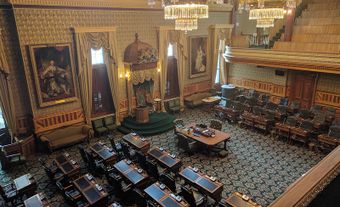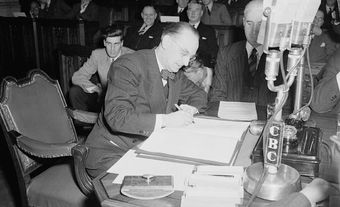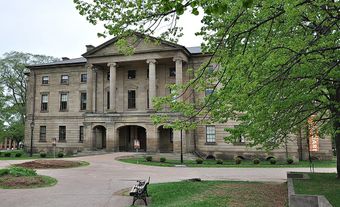The province of Nova Scotia has a majority Progressive Conservative government, formed on 17 August 2021. The premier of the province is Tim Houston and the lieutenant-governor is Arthur J. LeBlanc. Among Nova Scotia’s contributions to Canadian politics was the movement for responsible government, initiated by Joseph Howe, a political reformer, in 1836. In 1848, politicians in Nova Scotia formed the first responsible government in British North America.

Provincial Government Structure
Legally, executive power in Nova Scotia is vested in the lieutenant-governor; practically, however, it is exercised by the Executive Council or Cabinet, responsible to a 55-member legislature. Universal suffrage for males and females over 21 came into effect in 1920; the voting age was reduced to 19 in 1970 and to 18 in 1973.
Responsible Government
In October 1758 the first legislative assembly in Britain’s North American colonies met in Halifax, and parliamentary government was born in what would become Canada. Yet perhaps Nova Scotia's greatest contribution to Canadian democracy was the movement for responsible government, which got underway in earnest in 1836 when — mainly through the efforts of political reformer Joseph Howe and his newspaper The Novascotian — a majority of reform-minded assemblymen was elected to the legislature. Their struggle was against a Halifax oligarchy that dominated the business, political and church life of the province in its own interest, much like the Family Compact in Upper Canada; but what they wanted in practice was for the members of the Executive Council (Cabinet) to be responsible to the elected legislature, not to the appointed colonial governor.
The Reformers finally achieved success when, in the election of 1847, they won a seven-seat majority. In February 1848 James B. Uniacke became premier, with Howe acting as provincial secretary, together forming the first ministry operating under responsible government in British North America. Howe eventually became premier and also a federal Cabinet minister, despite having also led the movement to oppose Nova Scotia's entry into Confederation. (See also Nova Scotia and Confederation.)
Did you know?
Sir John Sparrow David Thompson is one of two Nova Scotian premiers to later become prime minister. He was elected premier in 1882, and served as prime minister from 1892 to 1894. Sir Charles Tupper, who championed Confederation as premier from 1864 to 1867, became prime minister in 1896. As federal Conservative leader Stanfield came close to leading the country, losing the 1972 national election to Pierre Trudeau by only two House of Commons seats.
History
The first genuine political parties in Nova Scotia appeared in the election of 1836 when the Tories (Conservatives) battled the Reformers (Liberals), who had come into existence almost overnight under the guidance of Joseph Howe. Until 1867 the parties contended fairly equally, but the Confederation issue upset the rough balance in favour of the anti-Confederates (Liberals). Up until 1956, the Conservatives won only four elections and were in office only 13 of the 89 years. Since the Second World War, however, a lessening in traditional voting within the Liberal Party and the influence of Conservative Premier Robert Stanfield combined to narrow differences in electoral strength and to make the parties genuinely competitive. In the 21st century the New Democratic Party has also grown in popularity, forming a breakthrough majority government — the first NDP government east of Ontario — in 2009.
It has been very difficult to supplant established Nova Scotian premiers. W.S. Fielding (premier 1884–96), George Murray (1896–1923 — an astonishing 27 years in power), Angus L. Macdonald (1933–40 and 1945–54), Stanfield (1956–67) and John Buchanan (1978–90) maintained their political ascendency over lengthy periods. However, to describe Conservatives Stanfield and Buchanan as less liberal or more conservative than Liberals Fielding, Murray and Macdonald would be a deception, since the old-line parties pragmatically base their programs and platforms on electoral needs, not on ideology. Nova Scotians have historically been moderate and largely "small-c" conservative voters.
Dexter to Houston: 2009–Present
The NDP's rise to power under Darrell Dexter in 2009 was all the more remarkable then. The party built its support incrementally over several decades, first in cosmopolitan Halifax and then among union-rich constituencies in rural Nova Scotia. Equally surprising was Dexter's defeat in 2013 at the hands of the Liberals under Stephen McNeil — and the sudden relegation of the NDP back to third-party status. The NDP loss marked the first time in over 100 years that an incumbent party didn’t win a second mandate.
On 30 May 2017, McNeil and the Liberals narrowly clung to a majority government, winning 27 seats (26 were required for a majority), 7 less than they held when the election was called. The Progressive Conservatives and NDP gained ground, winning 17 and 7 seats respectively. The Liberals’ shaky victory was attributed largely to voter anger over an ailing health care system.
In August 2020, McNeil announced his retirement. The Liberal Party held a leadership convention to choose McNeil’s replacement in February 2021. Because of the COVID-19 pandemic, and the public health measures surrounding it, the convention was held virtually (see also Pandemics in Canada). Iain Rankin, whose campaign focused on environmentalism and social justice, won the leadership race. He was sworn in as premier later that month.
In the provincial general election held 17 August 2021, Rankin’s Liberals lost to the Progressive Conservatives under the leadership of Tim Houston. Houston led his party to a majority victory, winning 31 seats. The Liberals won 17, the NDP 6 and an independent MLA 1. Houston campaigned primarily on the promise of significant health care spending. (See also Nova Scotia Premiers.)

 Share on Facebook
Share on Facebook Share on X
Share on X Share by Email
Share by Email Share on Google Classroom
Share on Google Classroom



